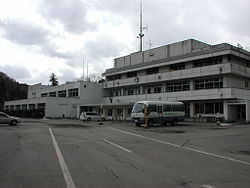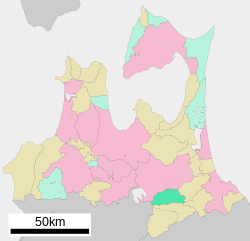Shingō, Aomori
Shingō (新郷村, Shingō-mura) is a village in Aomori Prefecture, Japan. In 2016, 2,495 people lived there. Its total area of the village is 150.77 square kilometres (58.21 sq mi).[1]
Shingō
新郷村 | |
|---|---|
 Shingō Village Office | |
 Location of Shingō in Aomori Prefecture | |
| Coordinates: 40°27′49.19″N 141°10′27.53″E / 40.4636639°N 141.1743139°E | |
| Country | Japan |
| Region | Tōhoku |
| Prefecture | Aomori Prefecture |
| District | Sannohe |
| Area | |
| • Total | 150.77 km2 (58.21 sq mi) |
| Population (October 2016) | |
| • Total | 2,495 |
| • Density | 16.5/km2 (43/sq mi) |
| Time zone | UTC+9 (Japan Standard Time) |
| - Tree | Aesculus |
| - Flower | Asian skunk cabbage |
| Phone number | 0178-78-2111 |
| Address | 039-0801 |
| Website | www |
Geography
changeShingō is in south-central Aomori Prefecture. It is east of Lake Towada. A lot of the village is mountainous. The elevation can be 1000 meters high near the border with Akita Prefecture. The village has a cold Humid continental climate characterized by cool short summers and long cold winters with very heavy snowfall (Köppen climate classification Dfa). The average annual temperature in Shingō is 8.7 °C (47 °F). The average yearly amount of rain is 1342 mm (53 in.). September is the wettest month. The hottest month is August; the average temperature is 22.2 °C (72 °F). The coldest month is January; the average temperature is -3.7 °C (25 °F).[2]
Neighboring municipalities
changeDemographics
changePer Japanese census data,[3] the population of Shingō has declined over the past 40 years.
| Census Year | Population |
|---|---|
| 1970 | 4,754 |
| 1980 | 4,332 |
| 1990 | 3,724 |
| 2000 | 3,343 |
| 2010 | 2,851 |
History
changeThe area around Shingō was controlled by the Nambu clan of Morioka Domain during the Edo period. During the post-Meiji restoration cadastral reform of April 1, 1889, Herai Village and neighboring Nozawa Village were formed. On July 29, 1955 the western portion of Nozawa Village merged into Herai, which was then renamed Shingō.
Education
changeShingō has two public elementary schools and two public middle schools operated by the village government. The village does not have a high school.
Economy
changeThe economy of Shingō is mostly agriculture. Notable crops include edible chrysanthemum, Japanese yam and tobacco. Traditionally a horse breeding area, Shingō is also known for its cattle ranches.
Transportation
changeRailway
change- The village has no passenger railway service.
Local attractions
changeShingō village has what is said to be the last resting place of Jesus. It is called the "Tomb of Jesus" (Kirisuto no haka). It's also where Jesus' last descendants, the family of Sajiro Sawaguchi, lives.[4] The Sawaguchi family says that Jesus Christ did not die on the cross at Golgotha. Instead, his brother, Isukiri,[5] took his place on the cross. Jesus left, and he went through Siberia to Mutsu Province (in northern Japan). Once in Japan, he changed his name to Torai Tora Daitenku. He became a rice farmer, and he married a twenty-year old Japanese woman named Miyuko. He raised three daughters near what is now Shingō. While in Japan, he supposedly traveled around. He supposedly died at the age of 106. His body was exposed on a hilltop for four years. Jesus' bones were collected, bundled, and buried in the mound said to be the grave of Jesus Christ.[6][7]
Another mound near the supposed grave of Jesus is said to have an ear of the brother of Jesus. It is also said to have some hair from Mary, the mother of Jesus. They were the only things from his family that Jesus could carry when he left Judaea.[8] The claims started in 1933 after the people found supposed "ancient Hebrew documents about Jesus' life and death in Japan."[6] They were supposedly the from Jesus. These documents are called the Takeuchi Documents. They are said to be very old documents that were passed down through the family of Takeuchi Kiyomaro. The documents were supposedly taken by the Japanese authorities, and the documents were taken to Tokyo, shortly before World War II. They have not been seen since.[9][10] However, someone has recently claimed to have recovered the entire story of Jesus in Japan from the Takenouchi documents. That the entire story of Jesus in Japan was copied into the designs of Nijo Castle gate before they were lost. The video he released contains many additional detail of the story that have never before been heard. Full Video of Theory Here
References
change- ↑ 詳細データ 青森県青森県新郷村. 市町村の姿 グラフと統計でみる農林水産業 (in Japanese). Ministry of Agriculture, Forestry and Fisheries. 2016. Retrieved 13 July 2017.
- ↑ Shingō climate data
- ↑ Shingō population statistics
- ↑ "From Japanese text of the sign included in this article".[permanent dead link]
- ↑ "Japan Travel: Jesus in Japan". Metropolis. Archived from the original on 2006-08-25. Retrieved 2006-12-13.
- ↑ 6.0 6.1 "The Japanese Jesus Trail". BBC. September 9, 2006. Retrieved 2006-12-13.
- ↑ "Land of the Rising Son". Fortean Times. May 1998. Archived from the original on 2007-03-10. Retrieved 2006-12-13.
- ↑ Bird, Winifred, "Behold! Christ's grave in Shingo, Aomori Prefecture", Japan Times, 25 December 2011, p. 10.
- ↑ "Land of the Rising Son". Fortean Times. May 1998. Archived from the original on 2007-03-10. Retrieved 2006-12-13.
- ↑ Okamoto, Ryosuke (2019). Pilgrimages in the Secular Age: From El Camino to Anime. Tokyo: Japan Publishing Industry Foundation for Culture. p. 109. ISBN 978-4-86658-064-7. Archived from the original on 29 May 2019. Retrieved 29 May 2019.
Other websites
changeMedia related to Shingō, Aomori at Wikimedia Commons
- Official Website (in Japanese)


